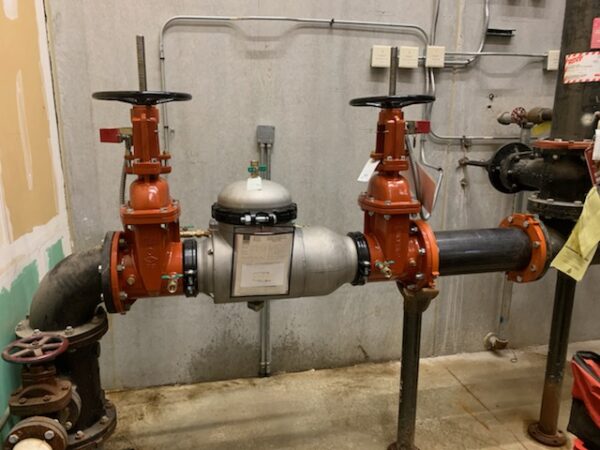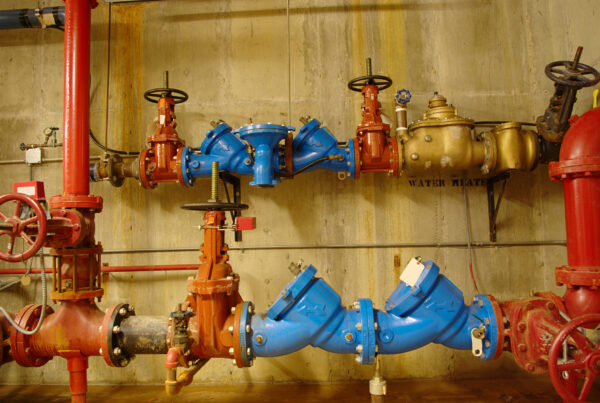Backflow

(847) 697-6623
SPECIAL PRICING AVAILABLE:
Quantity Discounts
Group Discounts
Special Irrigation Pricing
Neighborhood Fire Protection Pricing
Price Matching

What you need to know about Cross-Connections and Backflow
- Water is ordinarily distributed in one direction: from the supplier to the consumer. However, it is possible, and not all that uncommon for this to be changed by various hydraulic conditions. The flow of water may be effectively reversed, flowing from the consumer to the water supplier. This is called Backflow. The water supplier is then faced with the problem of having water introduced into the potable water distribution system from a source it cannot control: the consumer. If this consumer happens to have non-potable substances (those not suitable for human consumption) on the premise, these substances could find their way into the customer’s water pipes when backflow occurs. These substances could, in turn, get into the water distribution system. This causes contamination or pollution of the water distribution system.
- The physical connections between drinking water pipes and substances which are not meant for consumption are called cross-connections. To control these cross-connections and prevent backflow, a Backflow Preventer must be installed at the point of the cross-connection. These backflow preventers must be tested and inspected upon installation and yearly to determine their continued efficacy to prevent backflow.
Potential Hazards of not having a Backflow Prevention Device
- Contamination or pollution of a water system is usually brought about by a cross-connection to any system containing auxiliary water supplies which may be polluted or contaminated; irrigation systems which may be polluted or contaminated with fertilizers, pesticides or other objectionable materials. Thus, using a hose-attached sprayer for application of pesticides, solvents, cleaning products, etc; flushing a car’s cooling system with a garden hose; or filling a swimming pool can create situations where cross-connections can occur. Without proper protection, devices as useful as your garden hose have the potential to poison your home’s water supply. In fact, over half of the nation’s cross-connections involve unprotected garden hoses!

How Water Services Can Help
Water Services Company has been involved in the Backflow testing, Installation, Service and Sales for more than Twenty years across the Chicagoland area. We at Water Services can provide your company professional installations and certification for any type of backflow device.
Please scroll down to see our procedures.

Cross-Connection Control Survey Procedures
Cross-connection survey work should only be performed by personnel knowledgeable about commercial and industrial uses for both potable and process water. If “containment” is the prime objective of the survey, then only sufficient time need be spent in the facility to determine the degree of hazard inherent within the facility or operation. Once this is determined, a judgment can be made by the cross-connection control inspector as to what type of backflow protective device will be needed at the potable supply entrance, or immediately downstream of the water meter. If the cross-connection control program requires “total” protection to the last free flowing outlet, then the survey must be conducted in depth to visually inspect for all cross-connections within the facility and make recommendations and requirements for fixture outlet protective devices, and containment devices.
It is recommended that consideration be given to the following objects when performing a cross-connection survey:
- Determine if the survey will be conducted with a prearranged appointment or unannounced. Surveys are often conducted unannounced to ensure the most accurate “real time” operating circumstances.
- Upon entry, our certified team member will introduce themselves and produce credentials for review, authenticity and the purpose of the visitation as well as request to see the plant manager, owner, or maintenance supervisor to explain the purpose of the visit and why the cross-connection survey will be of benefit to him.
- We will ask what processes are involved within the facility and what purpose potable water is used, i.e., do the boilers have chemical additives? Are air conditionings cooling towers in use with chemical additives? Do they use water savers with chemical additives? Do they have a second source of water (raw water from wells, etc.) in addition to the potable water supply? Does the process water cross-connect with potentially hazardous chemical Leaching tanks, etc.?
- We will Request “as-built” engineering drawing of the potable water supply in order to trace out internal potable lines and potential areas of cross-connections. These drawings can be requested at Village Hall prior to site visit.
- Initiate the survey by starting at the potable entrance supply (the water meter in most cases) and then proceed with the internal survey if internal protective devices and fixture outlet protective devices are desired.
- Survey the plant facilities with the objective of looking for cross-connections at all potable water outlets such as: Hose bibs, Slop sinks, Washroom facilities, Cafeteria and kitchens, Fire protection and Siamese outlets, Irrigation outlets, Boiler rooms, Mechanical room, Laundry facilities, Production floor. All components will be photographed and labeled for report.
- Our certified specialist will make a sketch of all areas requiring backflow protection devices.
- We will review with the host what we have found and explain the findings to him. Inform them that they will receive a written report documenting the findings together with a recommendation for corrective action.
- We will document all findings and recommendations to be included in the written report. We include as many sketches or photos with the final report as possible. If the located cross-connection(s) cannot be eliminated, state the type of backflow preventer required at each cross-connection found.
- We will discuss all findings, answer any and all questions and discuss implementing changes or modifications with the municipality and a time frame for all work.
After the survey is completed Water Services will attach a copy of the Test Report to the device. All test results will be entered into the Water Services Backflow Database and copies made for Village record. Water Services will alert the municipality two months prior to its next test date.